Ubiquiti UAPSTMXG UniFi StadiumXG User Manual UniFi Stadium XG AP Quick Start Guide
Ubiquiti Networks, Inc. UniFi StadiumXG UniFi Stadium XG AP Quick Start Guide
Ubiquiti >
Contents
User Manual BK Part 1
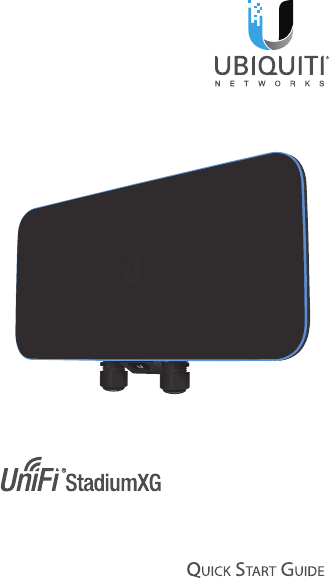
Quad-Radio 802.11ac
Wave 2 Access Point with
Dedicated Security and
Beamforming Antenna
Model: UAP-StadiumXG-BK
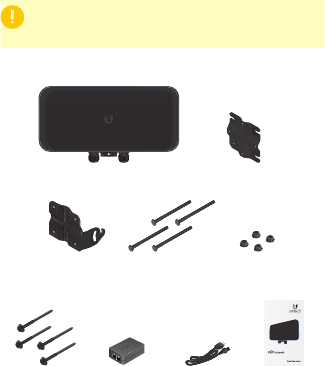
Introduction
Thank you for purchasing the Ubiquiti Networks®
UniFi®Quad‑Radio 802.11ac Wave 2 Access Point with
Dedicated Security and Beamforming Antenna. This Quick
Start Guide is designed to guide you through installation and
includes warranty terms.
IMPORTANT: The UAP‑StadiumXG requires the UniFi
Controller v5.7 or higher, available at:
www.ubnt.com/download/unifi
Package Contents
UniFi Stadium XG AP Adjustment Bracket
Pole Clamp Carriage Bolts
(Qty. 4)
Flange Nuts
(Qty. 4)
Quad-Radio 802.11ac
Wave 2 Access Point with
Dedicated Security and
Beamforming Antenna
Model: UAP-StadiumXG-BK
Lag Screws
(Qty. 4)
Gigabit PoE
(50V, 1.2A)
Power Cord Quick Start
Guide
TERMS OF USE: Ubiquiti radio devices must be professionally installed. Shielded Ethernet
cable and earth grounding must be used as conditions of product warranty. TOUGHCable™ is
designed for outdoor installations. It is the professional installer’s responsibility to follow local
country regulations, including operation within legal frequency channels, output power, and
Dynamic Frequency Selection (DFS) requirements.

Installation Requirements
• 13 mm wrench
• Cat5/6 UTP cable
Note: The UAP‑StadiumXG must only be installed
indoors. Due to its black color, it can potentially
overheat if installed outdoors.
System Requirements
• Linux, MacOSX, or Microsoft Windows 7/8/10
• Java Runtime Environment 1.8 or above recommended
• Web Browser: Google Chrome (Other browsers may have
limited functionality.)
• UniFi Controller software v5.7 or newer (available at:
www.ubnt.com/download/unifi)
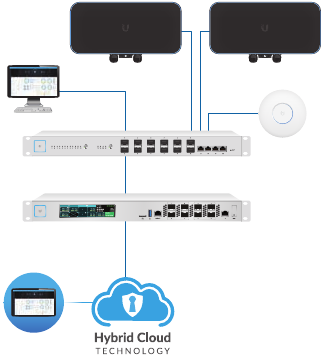
Network Topology Requirements
• A DHCP‑enabled network (for the AP to obtain an IP address
as well as for the wireless clients after deployment)
• A UniFi Cloud Key or management station running the UniFi
Controller v5.7 (or newer) software, located either on‑site
and connected to the same Layer 2 network, or off‑site in the
cloud or NOC
USG-XG-8
(DHCP Server)
US-16-XG
Internet
UAP-StadiumXG
LAN
WAN
Remote Access to
UniFi Controller
UAP-XG
UAP-StadiumXG
UniFi Hybrid
Cloud Install
DOWNLOAD THROUGHPUT & LATENCY DEVICES ON 2.4 GHZ CHANNEL
DEVICES ON 5 GHZ CHANNEL
UPLOAD THROUGHPUT & LATENCY
LATENCY THROUGHPUT
SPEED TEST
msec Mbps
7 0.94 1
2.33
25 22
597
0.9 116
200+0700+0
0.01 413
2290.2
2118
547
ACTIVE DEVICE
WAN
Inacve 0
Pending
0
Inacve 0
Pending
0
7
ACTIVE DEVICES
Inacve 0
Pending
0
118
ACTIVE DEVICES
LAN WLAN
DEEP PACKET INSPECTIONCLIENTSDEVICES
250
200
150
100
50
0
10
8
6
4
2
0
24 HRS 12 HRS NOW
Avg/Max Throughput Latency
Latency [msec]
Throughput [Mbps]
100
80
60
40
20
0
10
8
6
4
2
0
24 HRS 12 HRS NOW
Latency [msec]
Throughput [Mbps]
Network Protocols
Streaming Media
Web / Web 2.0
File Transfer
Social Network
Other
Motorola
Lenovo
SamsungE
Dell
Acer
Other
WLAN
LAN
WAN
118
7
1
582 GB
23.3 GB
22.7 GB
8.47 GB
3.6 GB
5.46 GB
258
241
220
213
130
110
126
DEVICES
645 GB
TRAFFIC
1172
CLIENTS
1 2 3 4 5 6 7 8 9 10 11
36 40 44 48 52 56 60 64
100 104 108 112 116 120 124 128
132 136 140 144 149 153 157 161 165
CURRENT SITE
Default
USERNAME
admin
Sample Network Diagram
All UniFi devices support off‑site management controllers. For
setup details, see the User Guide on the website:
www.ubnt.com/download/unifi
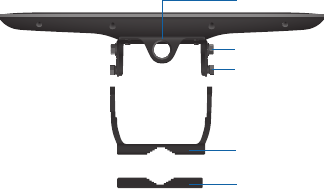
Hardware Overview
Top View
Adjustment Bracket
Pole Clamp
Lanyard Loop
Mounting Bolt
Elevation Lock Bolt
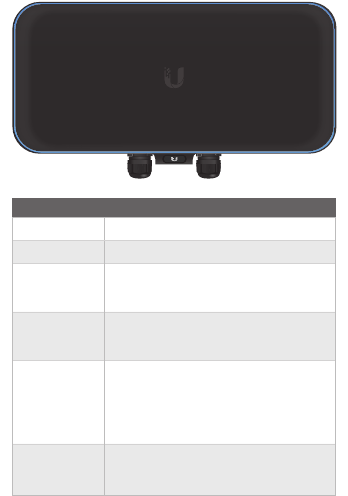
LED
The RGB LED is set to the factory defaults below; however, the
color and lighting pattern are software‑controllable.
LED Color Status
White Factory default, waiting to be integrated.
Flashing White Initializing.
Alternating
White/Blue
Device is busy; do not touch or unplug it.
This usually indicates that a process such
as a firmware upgrade is taking place.
Blue
Indicates the device has been successfully
integrated into a network and is working
properly.
Quickly
Flashing Blue
This is used to locate an AP.
When you click Locate in the UniFi
Controller software, the AP will flash. It
will also display the location of the AP on
the map.
Steady Blue
with Occasional
Flashing
Indicates the device is in an isolated state
(all WLANs are brought down until an
uplink is found).
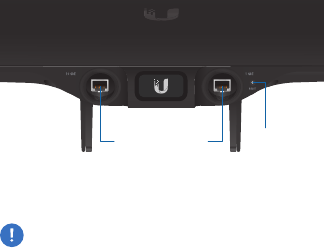
Ports
Reset
Button
10 GbE
Port
1 GbE
Port
10 GbE The 10 GbE port is a 1/10 Gbps Ethernet port used to
connect to the LAN and DHCPserver. It can also be used to
connect the power.
Note: The UAP‑StadiumXG can be powered using an
802.3bt PoE switch or the included Gigabit PoE adapter.
For instructions, see Powering the UniFi AP.
1 GbE The 1 GbE port is a 10/100/1000 Ethernet port used for
bridging. It can also be used to connect the power.
Reset The Reset button serves two functions for the
UAP‑StadiumXG:
• Restart Press and release the Reset button quickly.
• Restore to Factory Default Settings Press and hold the
Reset button for more than five seconds.
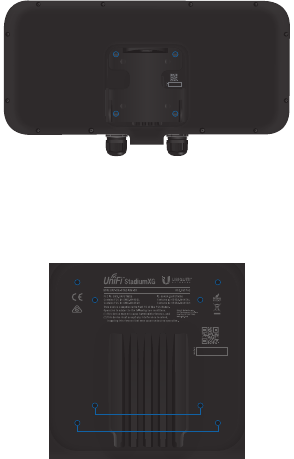
VESA Mounting
If you choose to use your own mount, remove the four M4 x 10
screws from the back of the UAP‑StadiumXG and detach the
pre‑installed mount.
The 8‑hole mounting pattern on the back of the
UAP‑StadiumXG follows the VESA MIS‑D standard and can be
used with mounts that comply with this standard. Use either
the 100 x 100 mm or 75 x 75 mm square hole pattern with
M4x 10 screws.
75 mm
100 mm
*640-00366-01*
640-00366-01
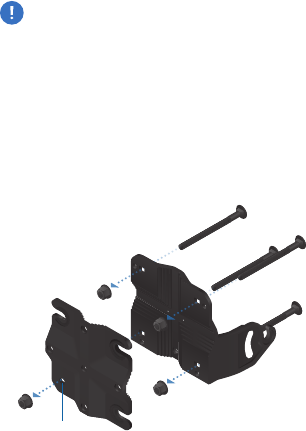
Hardware Installation
The UAP‑StadiumXG can be mounted on a pole or wall.
Proceed to the appropriate instructions for your installation.
Note: The UAP‑StadiumXG must only be installed
indoors. Due to its black color, it can potentially
overheat if installed outdoors.
Pole Mount
1. Attach the Pole Clamp to the Adjustment Bracket.
a. Hold the Adjustment Bracket with its clamps facing you.
b. Insert the Carriage Bolts through the rectangular holes
of the Adjustment Bracket.
c. Slide the single hole of the Pole Clamp over the
corresponding Carriage Bolt.
d. Place one Flange Nut on each bolt.
Pole Clamp
Hole
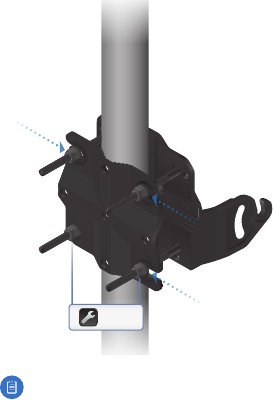
2. Mount the Adjustment Bracket on the pole and secure it.
a. Place the Adjustment Bracket against the pole.
b. Slide the three slots of the Pole Clamp over the
corresponding Carriage Bolts.
c. Tighten the Flange Nuts of the bolts to 25 N · m to secure
the Adjustment Bracket to the pole.
25 N · m
Note: The mounting assembly can accommodate a
Ø 25.4 ‑ 50.8 mm pole.
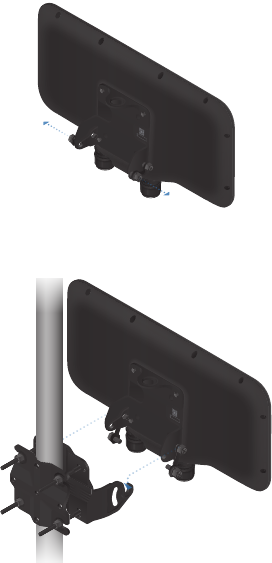
3. Loosen and remove the Elevation Lock Bolts on the
UAP‑StadiumXG. (The lanyards will retain the bolts.)
4. Lift the UAP‑StadiumXG and align the Mounting Bolts with
the slots on the Adjustment Bracket. Seat the Mounting Bolts
in the slots.
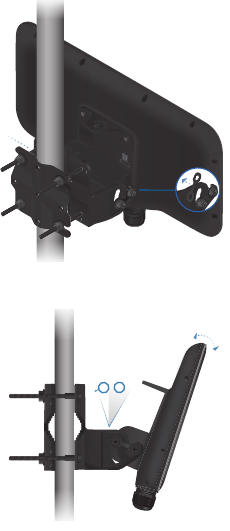
5. Insert the Elevation Lock Bolts into the adjustment slots.
Remove the lanyards and then tighten the bolts by hand.
6. Pivot the UAP‑StadiumXG until it reaches the desired
elevation angle (+10 to ‑50°). Then tighten all bolts.
10°
50°
7. Proceed to Connecting Ethernet.
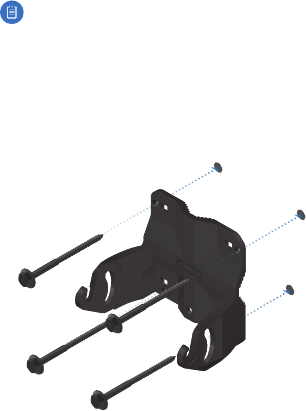
Wall Mount
To mount the UAP‑StadiumXG on a wall, securely attach the
Adjustment Bracket to the wall using the four Lag Screws.
Note: The Adjustment Bracket must attach directly to a
stud or other structurally stable surface.
1. Locate the stud.
2. Position the Adjustment Bracket on the stud, ensuring at
least two circular holes are centered on the stud.
3. Mark all four circular holes on the wall.
4. Drill pilot holes as necessary.
5. Secure the Adjustment Bracket to the wall with four
fasteners.
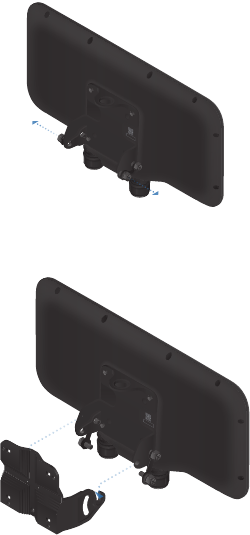
6. Loosen and remove the Elevation Lock Bolts on the
UAP‑StadiumXG. (The retaining lanyards will constrain
the bolts.)
7. Lift the UAP‑StadiumXG and align the Mounting Bolts with
the slots on the Adjustment Bracket. Seat the Mounting Bolts
in the slots.
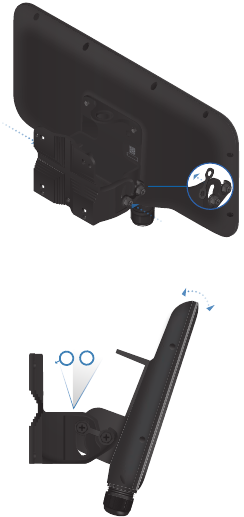
8. Insert the Elevation Lock Bolts into the adjustment slots.
Remove the lanyards and then tighten the bolts by hand.
9. Pivot the UAP‑StadiumXG until it reaches the desired
elevation angle (+10 to ‑50°). Then tighten all bolts.
-50
-40
-30
-20
-10
10
0
10°
50°
10. Proceed to Connecting Ethernet.
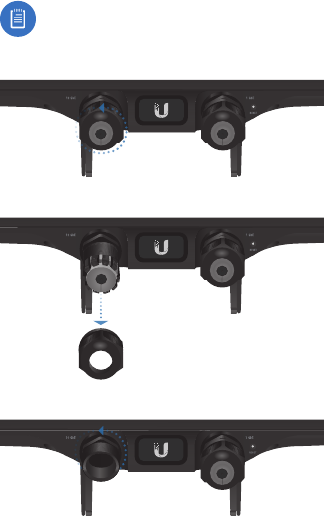
Connecting Ethernet
Note: If you are using TOUGHCable, we recommend
attaching the TOUGHCable Connector(s) after you
insert the cable(s) into the grommet.
1. Rotate the grommet cover counterclockwise to remove it.
2. Remove the plug from the grommet.
3. Rotate the grommet sleeve counterclockwise to remove it.